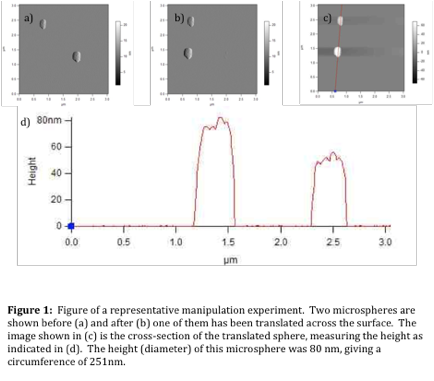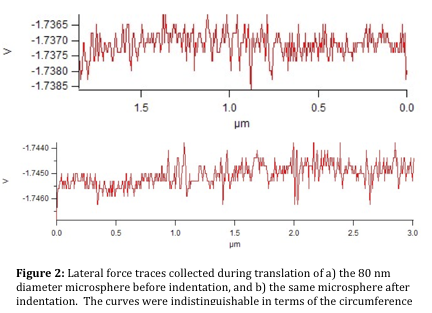AmericanChemicalSociety.com
Reports: ND5 48982-ND5: An Investigation of Rolling and Sliding Friction on the Nanoscale
W. Garrett Matthews, PhD, University of South Florida
The primary objective of the proposed research is to develop an understanding of how a nanoscale object's physical characteristics, including linear dimensions, adhesion, and elasticity, affect the tendency to slide versus roll when lateral forces are applied. The interplay between these properties will determine the transition point where a rolling mode of translocation (preferred for macroscopic objects) changes to a sliding mode. The work primarily focused on translating polystyrene microspheres across planar surfaces using the tip of an atomic force microscope cantilever while recording the torsion of the cantilever to measure the required force. Polystyrene microspheres are available in a broad range of diameters and provide a convenient system exhibiting controlled surface chemistry and mechanical properties. They also lend themselves well to surface modification through coupling chemistry, providing an additional avenue of investigation. The planar surface used as the underlying substrate is polished silicon wafer, again providing controlled chemistry and mechanics. In particular, the silicon exhibits silane reactivity via its oxide layer, allowing for facile modification of the substrate surface chemical properties. Additionally, the surrounding environment has a strong influence on the work of adhesion. Thus, the experiments will need to be done under controlled fluid environments.
Initial experiments were performed in
air to assess the suitability of the proposed experimental plan for Imaging and manipulation of the
microspheres were performed using an Asylum Reseach MFP-3D atomic force microscope
(AFM). MikroMasch cantilevers with
spring constants of 7.5 ~N/m were used, giving a torsional spring constant of
113.4 N/m. Typical experiments consisted
of 1. Imaging polystyrene microspheres deposited on polished silicon wafer
using the low shear intermittent contact mode, 2. Using the collected image, a
starting location for the tip and trajectory passing through a particle and perpendicular
to the long axis of the cantilever (for maximal lateral force sensitivity) was
selected, 3. The automated motion of the tip was performed in the so-called
contact mode, 4. During the force experiment, the cantilever position, torsion,
and normal deflection were recorded.
Such experiments were performed on the symmetric microspheres, followed
by repeating the procedure on microsphere which were subjected to large
indentation forces by the sharp point of the AFM cantilever. The indentation should introduce an
asymmetry, which would be detected in Fourier transforms of the lateral force
data collected during translation of a rolling particle across the planar
substrate. Shown in Figure 1 are two microspheres
and cross-sections measuring their diameters. Also shown is an image indicating the change in their
relative position after the manipulation experiment. Figure 2 shows the lateral force trace for translations
before and after indentation.
Periodic features corresponding to the dimensions of the particles were
not observed. Potentially, these results indicate
that the sphere was sliding during translation under these conditions. However, we believe the reliability of
the test for rolling behavior as described is likely to be unreliable for the following
reason. If the sphere rotated
about the axis parallel to the surface but perpendicular to the direction of
motion, it would have removed the asymmetry introduced by the indentation from
the area contacting the tip or the substrate. Thus we have begun developing an alternative experimental
approach. In conclusion, we have performed initial trials of the proposed
experiments investigating rolling friction. It was found that the experiments, as proposed, are likely
to be unsuccessful. An alternative
experimental plan has been developed and is being implemented. This new method is quite novel and has
several advantages, including increased through put for data collection.
 determining the translation mode. Deposition of the microspheres was as
follows. Polystyrene microspheres were
washed three times in nanopure water: the microspheres were diluted in water,
vortex mixed, and pelleted via centrifugation. The final dilution was 0.05% solids as calculated from the
manufacturer's specification. 30 mL was then pipetted onto a 1cm2
piece of plasma cleaned polished silicon wafer and incubated for 60s at room
temperature. Afterward, the
surface was lightly rinsed with nanopure water and dried under a nitrogen
stream. The samples were then
ready for imaging/manipulation.
determining the translation mode. Deposition of the microspheres was as
follows. Polystyrene microspheres were
washed three times in nanopure water: the microspheres were diluted in water,
vortex mixed, and pelleted via centrifugation. The final dilution was 0.05% solids as calculated from the
manufacturer's specification. 30 mL was then pipetted onto a 1cm2
piece of plasma cleaned polished silicon wafer and incubated for 60s at room
temperature. Afterward, the
surface was lightly rinsed with nanopure water and dried under a nitrogen
stream. The samples were then
ready for imaging/manipulation. We are changing our procedure to test
for rolling by using a fluorescence technique. We have found a method to produce microspheres with
fluorescent dye inhomogeneously distributed on the surface of the microspheres. When imaged from below while exciting
in total internal reflection, the intensity of the fluorescent emission will
fluctuate if the particles roll – the surface bound dyes will be excited
at varying distances from the substrate surface, producing fluctuating
intensities in emission intensity.
This substrate must be transparent, so we are using quartz cover slips
instead of the silicon wafer. The
surface chemistry remains essentially unchanged. This approach has the additional advantage of allowing us to
use shear flows in microfluidic channels to produce our lateral forces,
increasing the rate of data collection.
The method also greatly simplifies the collection of data under liquids,
expanding the types of experiments that can be performed.
We are changing our procedure to test
for rolling by using a fluorescence technique. We have found a method to produce microspheres with
fluorescent dye inhomogeneously distributed on the surface of the microspheres. When imaged from below while exciting
in total internal reflection, the intensity of the fluorescent emission will
fluctuate if the particles roll – the surface bound dyes will be excited
at varying distances from the substrate surface, producing fluctuating
intensities in emission intensity.
This substrate must be transparent, so we are using quartz cover slips
instead of the silicon wafer. The
surface chemistry remains essentially unchanged. This approach has the additional advantage of allowing us to
use shear flows in microfluidic channels to produce our lateral forces,
increasing the rate of data collection.
The method also greatly simplifies the collection of data under liquids,
expanding the types of experiments that can be performed.
Copyright © American Chemical Society

